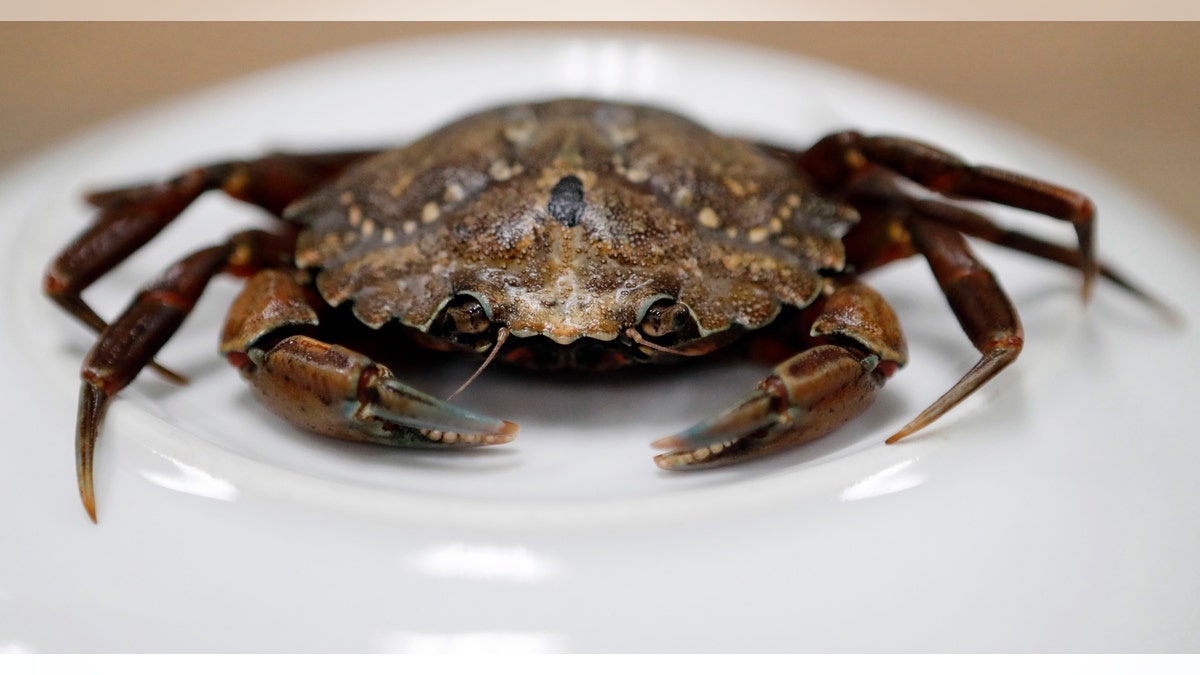
FILE - This June 6, 2018, file photo shows a green crab in Portland, Maine. A University of New England researcher said green crabs migrating from Nova Scotia are ornerier and angrier than their Gulf of Maine cousins. (AP Photos/Robert F. Bukaty, File) (Copyright 2018 The Associated Press. All rights reserved.)
Talk about being crabby.
Angry green crabs from Nova Scotia, angrier than their already ornery green cousins in Maine, are migrating south. They have started to destroy the coastal ecosystem off the shores of Maine, as they eat more than their share of soft-shell clams and wreck native eel grass, according to research from Markus Frederich, a professor at the University of New England.
"What we're seeing is this insane level of aggressiveness," Frederich told the Associated Press.
GIANT SPIDER WEB STRETCHES 1,00 FEET ACROSS LAGOON: THEY'RE HAVING A 'PARTY'
Though the green crabs are related, they're genetically different from one another. The angry Nova Scotia crabs have their roots in northern Europe and have adapted to cold water, while the slightly calmer Maine version came from the southern part of Europe.
They first entered the U.S. in the mid 1800's, according to the Washington Dept. of Fish & Wildlife. After arriving in Maine in the 1950's, they caused a soft shell clam population decline and then eventually made their way up to Nova Scotia.
"The green crab is most often confused with native helmet crabs or hairy shore crab," the Dept. of Fish & Wildlife wrote on its website. "The most distinctive feature is not its color – which can vary from reddish to a dark mottled green – but the five spines or teeth on each side of the shell. There are three rounded lobes between the eyes, and the last pair of legs are somewhat flattened. The carapace is broader than it is long, and seldom exceeds 3.5 to 4 inches across."
Louis Logan, a University of New England graduate student, had the unpleasant task of labeling the crabs captured from Nova Scotia waters for the research. The crabs were in no mood for games.
At a distance of 5 feet, the pint-sized brutes assumed a fighting posture. Those that grabbed him were in no hurry to let go.
"Any time I went down to grab one they went to grab me instead," he wrote in an email.
One of them, in particular, would jump out of the water in its frenzy to attack.
INDIANA MAN WARNS LOCALS TO 'BEWARE' OF GIANT SPIDERS AFTER SPOTTING 6-INCH CRAWLER AT WORK
During the research, both sets of green crabs were unleashed on a bed of eel grass and the Canadian species destroyed it, with Frederich comparing the damage to that of Edward Scissorhands, as they tried to look for marine organisms to eat.
Green crabs have been known to be particularly disruptive to existing ecosystems. The University of Washington has given some tips on what to look for and what do if they are found.
Additional studies will be done in the coming months to decipher whether a specific gene plays a role in the aggressiveness or if a factor called hybrid vigor is in play, Frederich said. The hybrid vigor theory suggests that crabs could be more aggressive as they establish themselves, but will mellow out later.
The quarrelsome newcomers currently comprise only about 2 to 3 percent of green crabs crawling on the ocean floor off Maine, but those numbers are certain to grow, Frederich said.
"It will be an entirely different ball game," he predicted. "It's just a question of when more of the crabs come and out-compete the Maine green crabs."
Eventually, the newcomers will move farther southward. "We can't do anything about it," he said. "The only thing that we can do is learn how to live with it."
The Associated Press contributed to this report. Follow Chris Ciaccia on Twitter @Chris_Ciaccia
